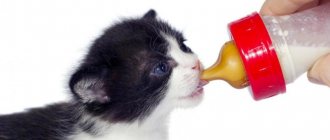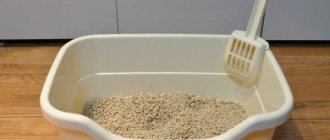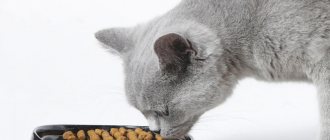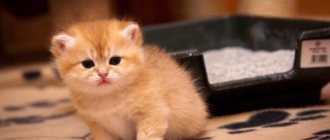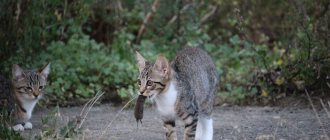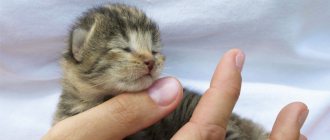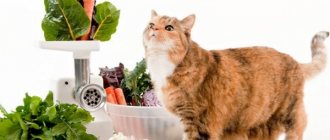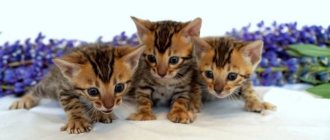Depending on the characteristics of the cat’s body, feeding kittens lasts from 40 to 60 days. At the beginning of life, the baby eats only mother's milk, and feeding it does not present any problems. This period lasts several weeks. The kitten suckles from its mother for only 3 hours a day, and the rest of the time it grows.
In order to determine whether a kitten is full or not, pay attention to its behavior: well-fed cubs sleep peacefully or suckle the cat, while hungry ones squeak, crawl around their mother or suck the finger extended to them. In this case, you need to feed the kittens. Babies left without a mother will also need feeding.
Features of specialized feeds
There is no need to fuss with cereals and broths, calculate calories, buy supplements and vitamin preparations, or come up with a menu for tomorrow. Others did everything for you. Just follow their advice on how much your pet should eat.
How much should you feed a kitten?
On the back of the package you will always find a table with the daily intake. Standards may vary from one manufacturer to another, as may the composition of the feed.
By the way, about the composition. Be sure to watch it. The inventors of cheap mass-produced food use almost no meat. Its “analogue” is minced meat made from bones, skin and even feathers. They do not disdain dyes and flavors. In addition, our pets are fed too many mineral salts. The benefits of such nutrition are questionable, but the harm is obvious. Low-quality food has little nutritional value, it is worth feeding once, the animal requires more and more food, but the most important thing is that a bad product causes kidney and liver diseases. By saving on food, you will splurge on the veterinarian.
So, how much specialized food should a kitten eat per day? The quantity depends on the weight of the cat. The recommended diet is 75% dry food, 25% wet food. There will be no harm if the amount of wet food (pouch or jar) is half the daily dose. Often, racking their brains about what to feed their 1-month-old kittens, owners mix dry and wet food in one plate. We do not recommend doing this. Better give it separately. Ideally, wet food should be at a comfortable warm temperature. If you warm it up a little (up to 38-40 degrees), it becomes more fragrant.
For feeding, it is better to use a low, wide container that is comfortable for the kitten. Vitamin-mineral complexes, no supplements needed
Only in individual cases, on the advice of a veterinarian. Important! Your pet should always have access to a container of clean, not cold water. Dehydration is a deadly enemy
If a kitten eats dry food, its body definitely needs four times more moisture. Sometimes you hear that animals are smart! – find the liquid themselves. They climb into the bathtub or kitchen sink, lick water from the walls... Moisture with residues of household chemicals - is this really what you should feed your cat?
How many times a day should you feed?
Often, on average 5-6 times a day, in small portions. By six months, reduce to three times. Adult cats are recommended to be fed twice a day. In general, the diet is considered correct if the kitten is well-fed, but the skeleton is easily palpable, looks healthy, the coat is shiny, and the weight increases with growth.
Natural food: how to feed it correctly?
Are you leaning towards natural foods? Approach this like an adult. A cat should grow up to be an omnivore, try different things, and not be stuck on one product. The argument that wild cats are mono-feeders in nature does not hold water. If rural hunters who catch mice meet the body’s needs for protein, carbohydrates, vitamins, and minerals, then where will you get a fresh mouse for a city dweller?
What can/should a kitten 3 months and younger eat?
- Meat, daily. Lean beef, chicken, turkey, rabbit. Boiled, raw or scalded. Cut into small pieces or ground into minced meat.
- Meat by-products: heart, liver, lungs, chicken stomachs. Ground or finely chopped, boiled or scalded.
- Milk, of course, every day. This is the basis of a child's diet. Later there will come a time when the body begins to poorly absorb this product. The teenager himself will refuse it. And for up to four months, this source of calcium is simply necessary.
- Fermented milk products: fermented baked milk, kefir, cottage cheese diluted with milk, low-fat sour cream.
- Fillet fish occasionally, no more than once a week. And only boiled. Raw fish (worms) and in large quantities (fluoride) are contraindicated.
- Eggs, quite often. Raw (whole, beating the yolk and white, or just the yolk) or boiled. Alone or with milk.
- Liquid porridge with milk or meat broth with the addition of meat. Oatmeal, oat flakes, buckwheat, rice, millet.
- Vegetables, raw and cooked. The kitten, of course, won’t bite the carrots, but you can crumble a little bit into meat pates and porridges. By the way, it is better not to use potatoes: starch is difficult to digest.
- A drop of vegetable oil a day to improve digestion.
- Ready-made vitamin and mineral complexes for kittens.
By the way, about the kitten, 1.5 months old. What to feed this baby? You can use ready-made baby food in jars - a mixture of meat and vegetables. Pates without salt, with vitamin supplements, are made from quality products.
What should you not feed your kitten (cat)?
- Pork (risk of contracting worms), fatty meat in general.
- Sharp, tubular bones (risk of injury, choking).
- Salty, spicy, smoked, fried, sweet, homemade canned food and sausage.
What should be included in a kitten's diet?
As soon as kittens develop milk teeth (by 4-6 weeks), this is a signal that their body can and should eat biologically appropriate food. The menu of cats as a species, both growing and already adult, cannot do without several components.
Meat, as well as fish, poultry, eggs, offal
Meat components should be at least 60-70% in the kittens’ diet. All these are sources of easily digestible animal protein, essential amino acids and other beneficial substances. If there is not enough protein, there will be no resources for the “construction” of tissues and organs.
Surprisingly, but true: meat products contain a lot of vitamins and minerals, no less than fruits and vegetables - as we used to think. At the same time, they are absorbed by cats much better. The problem is that during strong heat treatment, a significant part of them is lost, so manufacturers add them to most industrial feeds at the last stage.
We produce our feeds at a gentle temperature of 90°C, and a significant part of the raw materials enters the factory raw or fresh. All this gives results - we don’t have to further enrich the feed, and this is a huge plus! Those owners who stew or cook meat for kittens themselves need to introduce a vitamin and mineral complex into their diet.
Fat
Its importance for kitten nutrition is difficult to overestimate. Fat not only provides energy and supplies the body with Omega-3 and Omega-6, which affect the brain activity of animals, the condition of their skin and coat, and the development of the hormonal system, but also allows vitamins A and D to be absorbed. It is advisable to have fat in the kitten’s diet was not of plant origin, but of animal origin - for example, chicken, turkey, beef, salmon. And at least 18–20% of the diet.
Fat can be included in the diet of predators both in isolated form and as part of meat components, such as liver. This is why it is so difficult to calculate the proportion of fat in the natural diet of kittens: its deficiency weakens all functions, and its excess leads to obesity. When feeding with industrial feed, the percentage of fat is balanced and indicated in a guaranteed analysis, and its sources can be viewed on the package in the “composition” section.
Digestive Supplements
They contribute to better digestion of food, reduction of gas formation, disorders and regular bowel movements for pets. We have combined several different components of a kitten's diet into this category:
- prebiotics (soluble dietary fiber, a type of fiber). These are inulin, pectin, MOS and FOS. Prebiotics are naturally found in yeast, chicory root, Jerusalem artichoke, apples and a number of other vegetables and fruits. They, like any fiber, are not digested by cats, but break down into small particles and serve as food for friendly bacteria, maintaining healthy intestinal microflora;
- the living microorganisms themselves (probiotics). In addition to lacto- and bifidobacteria, which are found in fermented milk products, there are others that are no less useful and more resistant to the acidic environment of the stomach. For example, Enterococcus faecium, Bacillus subtilis and some others are added to modern animal feeds;
- coarse (insoluble) fiber. In small quantities (1.5–6%), predators also need it, as it forms stool and promotes better intestinal motility. This type of fiber is found in all components of plant origin, but for kittens, fiber in vegetables, fruits, healthy herbs and berries is better, because they have extremely delicate stomachs and coarse cellulose or, for example, grain bran can injure the mucous membranes.
Feeding regimen for a 5 month old kitten
In order for the kitten to grow, develop properly and not gain excess weight, it is necessary to avoid overfeeding and adhere to the feeding regime. For balanced feeding, you need to adhere to the following algorithm:
- Calculate the daily feed intake based on caloric content and protein content.
- Divide the daily feed amount by the number of feedings.
Having calculated the average portion, you need to take into account that the kitten’s hunger depends on its activity. Typically, activity occurs at certain times of the day.
The total number of feedings for a 5 month old kitten is approximately the following: 4-5 full meals and 1-2 snacks.
What kind of fish can be given to pets?
The habitat affects the composition of microelements in the fish’s body and its structure. These features determine the benefits and safety of using the product for your pet.
Marine
The main advantage of dishes made from this product is the high content of polyunsaturated fatty acids.
When you include it in your pet’s diet, it is possible to compensate for the deficiency:
- proteins;
- easily digestible fats;
- taurine, necessary for the functioning of the cardiovascular and urinary systems;
- tryptophan, which increases resistance to stress;
- lysine, which supports the functioning of the respiratory system;
- vitamins A, E, D, group B;
- microelements necessary for high-quality metabolism and proper functioning of the thyroid gland.
Sea fish are rarely contaminated with heavy metal salts and parasite eggs. An animal that eats it does not have an increase in cholesterol levels. The most preferred species to include in a cat's diet are pollock, hake and blue whiting.
Lake and river
Fish caught from fresh water contains large amounts of methionine.
This amino acid:
- prevents fat deposition on the liver;
- prevents bones from breaking down;
- normalizes the functioning of the nervous system;
- increases the absorption of vitamins C and group B.
Iron from freshwater fish meat is absorbed better than from sea fish.
By including catfish in your cat's diet, you can improve the functioning of its digestive system and brain. Eating pike or river pike perch strengthens the immune system and normalizes blood circulation. The disadvantage of dishes made from river or lake fish is the risk of infection by parasites. The greatest likelihood of cat fluke entering the body, which destroys the gallbladder and pancreas, occurs when the animal eats cyprinids.
River fish contains a lot of methionine.
Features and rules of feeding
When feeding a kitten aged 3-4 months, you need to consider a number of important points:
- the smaller and more active the kitten, the greater the frequency of feeding;
- an undernourished pet will develop more slowly and get sick more often, a constantly overeating pet will suffer from obesity and other diseases;
- decide in advance on the choice of food for your pet: natural food or ready-made food for kittens;
- introduce new foods gradually, without offering everything at once and alternating feeding different foods (the kitten gradually gets used to a certain diet);
- you cannot put the entire daily portion in a bowl: the baby has not yet learned to control his appetite and may overeat, and after a while the hungry body will have nothing to support its growth and playful state;
- monitor the temperature of the food served to him: the food should be warm;
- do not forget to add minerals and vitamins to your food;
- the kitten should have a separate bowl for warm drinking water (the drink should be changed frequently so that it does not stagnate, and the bowl should be thoroughly washed to prevent oxidation; the pet should have unlimited access to water).
What else can you give kittens?
Kittens can freely eat dairy products and gradually switch to adult food as they age. With proper breeding, kittens are allowed to be given condensed milk, but it must first be diluted with warm water in the following concentration: 1 part condensed milk and five parts water. Cottage cheese and fermented baked milk are suitable, but all products must be offered warm; children cannot eat food that is too cold or too hot, this also applies to adults. Low and high food temperatures contribute to the development of acute life-threatening conditions or the development of chronic diseases. In the first months of life, it is important to approach this issue correctly, since now the formation of immunity and the vitality of each cat is taking place.
Is it possible to give kittens milk?
Milk should be either from the mother, or in extreme cases, cow's milk; other types of milk are not suitable. If milk comes from a cow, it requires preliminary heat treatment. Milk gradually disappears from the diet, as it can cause various pathologies in the stomach, intestines and digestive system as a whole, since with age, adults cease to normally absorb and perceive lactose.
How to feed kittens milk?
Only after boiling using a pipette or a special bottle, if the individual is weak or due to age is not able to feed itself. Pipettes are suitable for the little ones. The milk should be at room temperature. Gradually, milk is added to the bowl, and the kitten learns to eat on its own, without the help of its owner.
What can you feed kittens by age?
An important rule: new food can be introduced into a kitten’s diet no more than once a week!
From 4 weeks - you can give the kitten boiled eggs (yolk only), cottage cheese diluted with milk or cream, liquid semolina porridge.
From 5 weeks - the kitten can be accustomed to solid food, it is better to start with chicken or turkey meat, because... it is easier to digest. The bird must be boiled and cut into very small pieces; it is better to grate it.
From 6 weeks – the kitten’s diet can be varied with dry food for kittens.
You can read more about what food to feed your cat in our article: Cat food: veterinarian recommendations.
If you do not want to feed your kittens ready-made food, continue to give your kitten chicken or turkey, you can start including boiled or scalded beef in the diet.
From 7 weeks - you can teach the kitten to eat rolled oats with fish. Mix very finely chopped boiled fish with rolled oats soaked in boiling water or milk
It is important to ensure that there are no bones in the fish.
Rolling Hercules will always give your kitten shiny and strong fur.
At the age of 8 weeks, the kitten should already be able to eat and drink on its own without assistance.
Kitten food
Modern foods provide all the necessary forms of release for kittens, that is, balanced diets have been developed separately for them, both for liquid food and for dry food. It is necessary to start with the liquid type, since the hard, kitten with immature teeth cannot consume normally and can harm its health and life.
Dry
Veterinarians will tell you which food is suitable for feeding in relation to the calorie content and nutritional value of a particular species. It is recommended to purchase food in small portions, but you should not purchase some of the cheapest or most expensive products for nutrition; turn to the middle segment.
Dry food is always diluted with water or broth, always warm; by the age of 5 months this can be abandoned, but some animals prefer to eat liquid food throughout their lives, this is quite normal.
Wet
Wet varieties of food are also sold freely, both in veterinary pharmacies and in supermarkets. Be sure to check expiration dates before purchasing. There should be a mark on the food stating that it is suitable for feeding babies. It is recommended to give wet food either separately or mixed with other liquid products, this could be porridge or broth. In some cases, wet food can be mixed with cooked fish or meat. It is also better to choose average prices.
Canned food
High-quality canned food contains all the beneficial substances a 1.5-month-old kitten needs. And rather than feed your baby haphazardly from the table, it is definitely better to buy a ready-made nutritious lunch. Canned food is given according to the manufacturer's recommendation from 2 months, but fermentation can reduce this age to 6 weeks. Such elements are already semi-digested, they are easier to digest and do not burden the gastrointestinal tract. Of course, we are only talking about good food for the little ones:
- Animonda, Nature's Protection;
- 1st Choice, Brit Care, Almo Nature;
- Hill's, Pro Plan, Royal Canin.
Canned food cannot be combined with natural products; you need to choose one. The final chemical composition of the intestinal flora and gastric juice is still being formed. The ready-made diet contains easily digestible elements to which the baby’s digestion quickly gets used to. Digesting regular food requires different enzymes and more time. Therefore, the combination of canned food and natural food causes stress and disrupts the functioning of the gastrointestinal tract.
Vitamins, minerals
Vitamins, minerals, amino acids must be supplied to the kitten’s body with food and feed. Ready-made high-quality feed contains all the necessary substances, so the ready-made diet is not supplemented with vitamin-mineral complexes and additives.
If the kitten receives natural food, to replenish the deficiency of vitamins, minerals, amino acids, ask your veterinarian what vitamin preparations to give your pet.
It is best to use complex formulations (Brevers, Stress Tabs for kittens) in tablets, capsules, or powder. At five months, the kitten’s body needs proteins, amino acids, calcium, phosphorus, iodine, iron, vitamins A, B, C.
At 1.5 months
Below we will consider how and what to feed a 1.5 month old kitten at home:
At this age, the pet can already feed on its own, and its diet should be balanced. At this age, the kitten can be fed:
- rolled oats and buckwheat porridges;
- vegetables (any vegetables, except potatoes, served boiled or raw);
- raw meat (low-fat varieties). Served raw, boiled or scalded with boiling water. Meat products make up from 60 to 80% of the total daily food volume.;
- boiled offal;
- cottage cheese - 30 g per day, preferably not fatty;
- raw fish, previously doused with boiling water (about 1 time every 7 days);
- greens (you can ask at the animal department).
How often should I feed?
Kids eat a lot, 5-6 meals a day is the norm. In general, a kitten should eat 120 g per day. The baby cannot eat this amount at once. If the kitten eats less than normal, then you should try changing the food. If the animal refuses food, it is better to contact a veterinarian.
Once the kitten reaches 2 months, you can feed it a little more - up to 180 g
At this moment, it is important to monitor the pet’s activity - more playful and active animals need more food.
If you are going away for the day and leaving your kitten alone, feed him before you leave and leave some food in his bowl and feed him more when you return.
Food additives
Do not neglect this important point - vitamins and supplements will have a beneficial effect on the kitten’s body.
From 1.5 months you can add to food:
- Kitzim;
- "Doctor Zoo";
- "Brevers";
- "Farmavit";
- "Biofar".
Before purchasing vitamins, consult with specialists. Veterinarians can advise you on which food supplements are best for your pet and whether your pet needs them at all. The most popular supplement for cats is fish oil. Veterinarians advise giving it 2 capsules for 7 days.
What not to give to a kitten
Every caring owner should remember the list of prohibited foods. Kittens should not eat:
- food with spices (the kind that people like);
- fatty meat: pork, beef;
- human medicines;
- sweets;
- river fish;
- legumes;
- fatty dairy products;
- flour;
- potatoes.
Is it possible to have ready-made food at 1.5 months?
Cat owners and veterinarians do not recommend mixing food and natural food. Many people primarily purchase ready-made cat food for a number of reasons:
- saving time;
- nutritional balance.
If you want to feed your pet food, you should consider that:
- it will not be possible to switch to natural nutrition;
- You cannot mix food of different brands, as they contain different microelements;
- Only high-quality commercial feed is suitable for feeding.
Choose high-quality, balanced food and your kitten will not have any health problems.
Kittens love wet food, but it's a little more expensive. However, according to veterinarians, dry, high-quality ones are more useful.
It is worth noting that wet food contains about 80% water, and your pet does not need to constantly drink water. With dry food, everything is different - there should always be a clean bowl with drinking clean water near the food bowl.
Veterinarians consider the following brands to be good food:
- Royal Canin;
- Almo Nature;
- Pro Plan Junior;
- Eukanuba Puppy Kitten.
The price tag may scare the kitten's owners, but believe me, by purchasing good food, you only win. You won’t have to buy additional vitamins, and the kitten will be healthy, and you won’t have to spend money on treatment.
Norm of daily portion
The size of the daily portion depends on the type of diet. Dry food is dehydrated, meaning that almost all the moisture is removed from it during production. For this reason, cat “crackers” will always have more calories than regular food, provided they have the same weight. How much “drying” to give per day can be found here.
The average daily portion of wet food should be 5% of the animal’s body weight (for kittens up to 9 months - 10%), but instead of average values, it is better to use a special formula to calculate calorie content. Its main advantage is taking into account the individual characteristics of the pet: activity level, age, body constitution, the presence of castration or sterilization, pregnancy and lactation.
Feeding dry food
The daily serving norms, taking into account the weight and age of the animal, are indicated on each package of dry food. The problem is that they differ from each manufacturer.
This is due to the different nutritional composition and purpose of the granules. In this case, you can go in two ways: strictly follow the indicator specified by the manufacturer or calculate it yourself, taking into account the caloric content your pet needs.
Feeding with wet food or natural food
Canned meat and spiders are used as the main diet or in addition to dry pellets. They are not mixed with “natural” ones. Unlike "crackers", wet food contains much more liquid. Thanks to this, saturation occurs with a smaller portion size.
The calorie content of 100 g of dry food is equal to approximately 250 g of canned food and 450 g of spider contents. When combined with “drying”, the number of meat pieces should be about 30% of the total diet.
The daily intake of regular food is calculated either as 5% of total body weight, or using a special formula for calculating calories. When using “natural” food, you will also need to take into account the amount of proteins, fats and carbohydrates consumed. Their ratio should be 52:36:12.
Features of development of kittens at 1.5 months
The developmental characteristics of kittens at 1.5 months vary greatly, depending on the breed, lifestyle and quality of care. Statistically, at one and a half months, kittens are ready for supplementary feeding. However, there are late maturing breeds, so if one and a half month old kittens suckle their mother and she does not object to feeding the offspring, there is no need to rush into supplementary feeding.
Healthy one and a half month old kittens should be active and interested in exploring the outside world. Kids should hold their heads well, walk confidently and begin to hone their first hunting skills. At one and a half months, the kitten learns to control its claws, run and maneuver while running.
If there are several kittens in a litter, they actively play with each other, with one of the kittens imitating hunting and the other imitating defense. If kittens are already on complementary foods, they should actively respond to food smells.
At one and a half months of age, babies quickly adapt to the feeding schedule and expect food at the usual time. Being with their mother and receiving supplementary feeding, the kittens still actively suckle milk and become very worried when their mother is absent for a long time.
The thermoregulation of kittens does not work fully, so the mother cat sleeps with the offspring, warming the babies. Between one and a half to two months, kittens will begin to go to the toilet on their own, so it is better to move the mother’s tray closer to the nest.
Water
Regardless of the type of diet, the kitten should always have access to fresh drinking water. It is best to use filtered, bottled water, since running tap water contains chlorine and other chemical compounds.
Water bowls can be made of plastic, ceramics, clay, stainless steel, but not only aluminum. Place them close to where the kitten eats food.
Change the water twice a day. Wash bowls well with running water without using household chemicals.
The importance of proper nutrition
If you have a small pet, you need to have an idea of how to properly and effectively feed a kitten in order to raise a healthy and happy animal.
The lack of a balanced diet affects the development and growth of the baby and can lead to physical disabilities, problems with internal organs and even death.
If the food is not selected correctly, this can lead to an allergic reaction in the young body, which can also affect the growth of the animal.
In turn, we must not forget about the baby’s feeding schedule, which differs from the feeding schedule of adult cats.
Did you know? Not all cats can boast of the ability to hunt rodents. But those who regularly eat mice replenish their bodies with large amounts of trace elements, such as sulfur, which contributes to the health and beauty of the mustachioed hunters' fur.
Is it possible to give cats raw fish?
Most veterinarians do not recommend offering raw fish products to cats. The main danger with this option of consuming fish products is the helminth parasite that lives in fish. Opisthorchiasis caused by parasites can lead to damage to the gallbladder, liver, and stomach. If not treated promptly, this disease can cause the death of your pet.
© shutterstock
Is it possible to feed cats sea fish without heat treatment?
The question of whether raw sea fish can be given to cats is controversial among cat breeders. It is believed that only river fish are infected with parasites, but in fact, sea fish are no exception. Fish that live in the sea are 25% less affected by helminths than river fish, but their consumption without cooking is not safe.
When feeding cats with fish caught at sea, it should be taken into account that the following species are in the lead in terms of the degree of infection with worms::
- herring
- mackerel
- blue whiting
- sprat
- bull
- anchovy
These fish varieties are subject to particularly stringent heat treatment requirements.
Parasites are practically not found in hake, pike perch, whiting and pelengas. You can occasionally give small pieces of raw fish of these types, if the product has previously been seriously frozen.
© shutterstock
What not to feed a one and a half month old kitten
When preparing a diet, it is important to know what not to feed a one and a half month old kitten. The following foods are contraindicated in the diet of a cat at any age:
The following foods are contraindicated in the diet of a cat at any age:
- Bones, pure fat, skin, especially poultry.
- Palm oil.
- Grapes, raisins.
- Juicy and sweet fruits.
- Soy.
- Mushrooms.
- Corn and semolina.
- Raw freshwater fish.
- Dry, salted fish.
- Products containing sugar or sugar substitutes.
- Products containing xylitol (chewing gum, some sweets).
- Products containing flour or yeast.
- Products containing caffeine, cocoa, any stimulants (sweets, tea, coffee, chocolate).
- Products containing marinades, salt, spices.
- Smoked products, including sausages, balyki, fish.
- Expired products.
- Food for dogs and adult cats.
- Dry food.
- Leftovers from the table.
Controversial foods in a kitten's diet are:
- Fresh pork is a source of helminths and false rabies.
- Raw ocean fish are a source of helminths.
- Whole milk – risk of individual intolerance.
- Chicken eggs are an allergen.
- Factory-bred chicken – risk of allergies and individual intolerances.
- Raw and boiled chicken liver in large quantities.
- Cereals.
List of foods that kittens should not feed
To prevent your pet from developing health problems, the following foods should be excluded from his diet:
- Cow's milk. It causes diarrhea in kittens; cow's milk can be replaced with goat's milk.
- Fermented milk products with high fat content.
- Fish – this product can be given to adult cats, but it is not recommended for kittens.
- Salty, fried, sweet and spicy foods.
- Any sausage products.
- Potatoes in any form.
- All legume products.
- Cheese.
- Pork meat.
- Chocolate.
- Flour products.
When should you start complementary feeding and how many times should you feed your kitten per day?
Experts recommend introducing complementary foods into the diet with
the appearance of the first milk teeth, at the age of 3-4 weeks.
In some cases, it is necessary to start complementary feeding earlier - the cat’s milk supply is low, mammary gland diseases, multiple births, when kittens do not have enough milk and they begin to lag in growth.
In order to know whether the kittens are receiving enough essential nutrients, you need to weigh them regularly, and if they fall behind, start feeding the kittens.
When controlling your weight, take into account the following standards:
- At birth, the average weight of a kitten is 100 g, plus or minus 20 g, which depends on heredity and breed.
- After about 10 days, the weight doubles, and subsequently increases by an average of 100 g per week.
- At two months, a large breed kitten should weigh on average 1100 g, plus or minus 200 g, while male cats weigh more than female cats.
It also happens that kittens are left without a mother and the owner has to take full charge of feeding.
Frequency of feeding kittens depending on age:
- In the first 14 days of life - 10 meals;
- From two weeks to one month, reduced to 8 meals;
- By two months they switch to feeding 7 times a day;
- From the 2nd to the 3rd month they feed 6 times;
- From 4 to 5 – 5 times;
- From 5 to 9 – 4 times;
- From 9 to 12 – 3 times;
- After a year they switch to two feedings a day.
In the case of artificial feeding, from birth to one
months, kittens are fed at night. The above norms are approximate, just as the interval between feedings is approximate; small kittens themselves will let you know when it’s time to feed them, showing concern.
Do cats like fish?
Cats love the foods they are used to. Pets are constant in their taste preferences and prefer stability. However, the owners think that the cat wants different foods, and experiments with the diet begin. Approximately in this way, the cat owner comes to the conclusion that the pet needs to be fed fish. Some owners feed their children fish since childhood, which essentially does not change the situation.
Let’s immediately make a reservation that you cannot constantly feed fish to a kitten or an adult animal. Sterilized cats and neutered cats can only have fish as a treat, and it is better not to give them at all. Let's look at the main misconceptions that guide owners when breaking these rules.
Many people say “my cat loves fish and eats it all her life, she is healthy and happy.” Conclusions about health and happiness are clearly exaggerated, but the fact that the cat eats its usual food should not be disputed. Let's figure out who is the ancestor of the domestic cat? Research has shown that the progenitor of the cat family comes from Africa, more precisely, from its desert region. Considering the shortage of fish and the fear of water among ancient African cats, it is not possible to assume that they ate fish.
We will not deny the fact that there are fishing cats in the world, but these are literally several species from the entire family. Natural food for a cat is meat, that is, game. A wild cat will eat fish if it finds it or accidentally catches it. However, given that cats prefer to stay away from water, the issue of fishing fades into the background. It’s much easier for a cat to catch a mouse or a bird – that’s a fact.
Domestic cats are accustomed to eating fish, since in some regions it was a commercial product. Simply put, humans didn't need to spend money on fish (unlike meat), so cats ate what was available. Conclusion: Domestic cats eat fish only because it is forced on them by humans.
“In the villages, cats always eat fish and everything is fine” or “no one watches the street cats, they eat fish and the remains of it and everything is fine.” Again, we will not dispute the fact that cats eat fish, but are they doing so well? Statistics show that outdoor cats hardly survive beyond 5–6 years of age. Cats from villages could potentially live much longer than they do. Judge for yourself, after all, in a village a cat leads a natural lifestyle, receives natural products, so why does she live as long as a city dweller?
“We fed the cat only fish every day and she lived for 15 years.” Yes, and this is possible, because the potential health of each cat depends on many factors. Among cats, there are also long-livers who could please their owners for 20–25 years, but live only to 15. Take it as a fact that if a cat does not get sick due to improper feeding or insufficient care, this is the exception, not the rule.
“Cats need fish oil; even good food is made from fish.” This argument is the most reasonable. Cats do need trace minerals, fatty acids, fish oils and proteins, all of which come from fish. Some foods are indeed made from fish, but only noble varieties. We'll look at it in more detail below, but for now let's identify the main disadvantages of fish in a cat's diet.
Kitten food should be tasty
A reasonable compromise is the right decision of a caring owner. Feeding an animal only meat and offal is not the best solution. Experts recommend offering heart, liver, and lungs to your pet several times a week, replacing a meat dish. Proper nutrition requires variety; foods need to be mixed (for example, oatmeal with meat, vegetables and egg yolk).
Delicious food for your baby does not contain salt or spices. Before feeding, warm up cold food and cool hot food, take care of the animal. Provide your pet with a bowl of water and constantly check the contents and freshness.
Raw vegetables are not suitable for feeding small pets. Boil them and you will get a tasty dish suitable for the age of a small fluffy ball.
Have you decided to introduce a new product? Keep it in moderation, the first portion is very small, just introducing the kitten to a new taste.
Breastfeeding raises a lot of controversy. It is known that full-fat cow's milk often causes intestinal disorders. Experts advise purchasing special mixtures from veterinary stores. Goat's milk is a good option; it is easier for animals to accept.
Drinking regime
Regardless of the type of feeding, the water must be cleared of impurities and changed at least once a day, and in the summer - at least 2 times a day. Tap water contains salts that are dangerous to the body, and long-standing water contains bacteria and other harmful microorganisms.
Please note that for comfortable absorption of “drying”, much more liquid is required than for “natural” ones. If your pet is too lazy to reach the water bowl in the kitchen, buy a few more pieces and place them throughout the apartment.
Veterinarian advice
The first and most important thing that veterinarians remind you of is that your pet’s diet should be stable, without surprises or sudden changes. It is recommended to immediately determine whether the pet will receive natural food or a ready-made balanced diet. If the animal eats food, fresh foods should be introduced into its diet occasionally, as complementary foods.
For an animal suffering from constipation or other stool disorders, eating disorders are most often characteristic. If the owner gives porridge and meat one day, and only dry food the next, this is guaranteed to lead to problems in the digestive system. It’s worth talking to the breeder about what diet the baby is used to.
It is recommended to give seafood with caution - they can cause increased intestinal motility or lead to stool upset. If problems have already arisen and last more than a day, the animal loses appetite, becomes weaker, or discharge appears from the eyes, you should immediately consult a doctor
For information on what to feed British breed kittens, watch the following video:
Is fish good for castrated animals?
Many breeders believe that castrated cats should not be given fish. The reason for this is the opinion that it is castrated animals that are most susceptible to urolithiasis. In fact, post-neutered male cats are just as likely to develop urolithiasis from excessive fish consumption as unsterilized pets.
© shutterstock
You should not give castrated cats, like unoperated male cats, fish in large quantities. This can reduce the content of vitamins B1 and E in the body, leading to the development of anemia and damage to the thyroid gland. The reasons for such consequences are the enzyme thiaminase and iodine contained in fish, which is especially abundant in marine fish species. The feline thyroid gland is not able to absorb this amount of iodine, and this can lead to the development of goiter.
Feeding a kitten without a mother
Feeding a kitten without a mother, that is, with ready-made formulas (milk substitutes), encourages the body to form and adapt faster. Practice shows that artificially fed kittens are ready to receive supplementary feeding at 3–5 weeks of age.
Feed your artificial kitten liquid foods for as long as possible. The digestive system of cats is much more sensitive than that of humans. Taking into account the fact that the gastrointestinal tract of an artificial kitten is partially populated by pathogenic microflora, it must be spared as long as possible.
The reaction to all new foods that you introduce into your kitten’s diet should be carefully monitored. If diarrhea, signs of food allergies or other alarming symptoms develop, foods are removed from the diet and reintroduced no earlier than a month later.
List of natural products
A diet made from natural products is considered a more natural and optimal choice:
- Feeding raw and cooked foods in pure and mixed form.
- Feeding exclusively raw foods – for kittens older than 3 months.
- Feeding with homemade semi-finished products.
Supplementary food for kittens should be based on dairy products:
- Goat milk diluted with boiled water.
- Scott's kitten mix.
- Tiling mix for kittens.
Scott's kitten formula was invented before milk replacers were introduced. The mixture contains yeast and is prepared per 1 kg of weight, so be careful when dosing and storing.
Recipe:
- Homemade, not separated cow's milk – 50 g.
- Powdered milk – 15 gr.
- Dry yeast (nutritional) – 3 gr.
- Chicken egg (yolk and white) – 50 gr.
- Chicken egg white, beaten until foamy – 50 g.
- Sunflower oil, refined – 1 gr.
- Glucose (powder or pharmacy) – 4 g.
Place all ingredients in a ceramic bowl and mix thoroughly with a whisk until smooth. Using a syringe, draw the required amount of the mixture into a bottle and heat it to 38 degrees. The mixture is stored in a refrigerator in a ceramic container covered with cellophane and paper. Shelf life no more than 3 days!
Recipe:
- Homemade, not separated cow's milk – 25 g.
- Powdered milk – 5 gr.
- Glucose (powder or pharmacy) – 2 g.
- Vitamin supplements for kittens (industrial) – 1 g.
Whisk all ingredients in a ceramic container. If the powdered milk does not dissolve well, warm the container slightly. Take the mixture into a bottle and heat it in a water bath to 38 degrees. The mixture is stored in a refrigerator in a ceramic container covered with cellophane and paper. Shelf life no more than 3 days!
If the kitten actively eats supplementary food from a saucer, its diet can be expanded by introducing foods one at a time:
- Whole cow's or goat's milk.
- Calcined cottage cheese.
- Dairy products.
- Bouillon.
- Boiled minced meat (carefully chopped).
Kittens, developing at a standard pace, begin to be interested in meat at one and a half months of age. To encourage children's interest, you can introduce chopped, raw, boiled or pre-frozen beef into the diet.
Industrial food for kittens at 1.5 months
For the first supplementary feeding and subsequent formulation of the diet, you can take industrial feed as a basis. Do not take this step if you are not sure that you can keep the kitten on ready-made food until at least six months of age. If you plan to feed your pet high-quality industrial food, the menu at one and a half months of age consists of:
- Milk substitute.
- Semi-moist food - pieces with gravy or jelly.
- Wet food - pate or paste.
A milk replacer should be present in the diet on an ongoing basis:
- Katzenmilch – possible from day one.
- Hartz milk powder.
- Babycat Milk (Royal Canin) - according to the instructions, it is possible only from 2 months, but the mixture can be used earlier if there are no alternatives.
- Beaphar Kitty-Milk.
- Gimpet Cat-Milk.
- Nutri Vet.
- Just Born.
- Nurturall-C.
- Pet Lac.
If the kitten is stunted or does not eat cat milk substitute well, infant formula can be used for supplemental feeding.
- Nutrilon.
- Nestozhen.
- Little Istrinsky.
- Baby.
Care in the first days
It is better to feed kittens by holding them. Like babies, they need to be held in an upright position after feeding so that they can burp, releasing excess air.
In the first 2 days
For kittens, it is enough to give 1 teaspoon of milk every 2 hours. The dose should increase as the animals grow. It is advisable to weigh the kittens every day and keep records. If they aren't gaining weight, that should be a red flag.
Starting from day 8
Babies should be given liquid vitamin preparations prescribed by a veterinarian every other day. Raw cow's milk is contraindicated for newborn kittens. You can use ready-made cat milk or dry formulas - cat milk substitutes, which are sold in veterinary pharmacies. In any of the above cases, you will need a bottle and nipple (some manufacturers of ready-made cat milk put the bottle and nipple inside a jar of dry formula). They can also be purchased at veterinary pharmacies. You can use a plastic eye dropper or syringe (without a needle). The main requirement is sterility. Bottles and teats should be cleaned and boiled regularly. The food supply is prepared for no more than 24 hours and stored in the refrigerator.
The food must be heated to 38ºC, and when giving it, you must ensure that the kitten sucks milk itself. Milk should not be introduced by force, as the baby may choke. When the kitten falls asleep or when milk bubbles come out of his mouth, this means that the baby is already full. It is important that kittens suckle themselves through the narrow holes in the nipple and prepare themselves for the “drinking work”. Do not give milk through a wide opening. This often leads to milk entering the respiratory tract and causing pneumonia.
In the first 3 weeks
The kitten should be given 1 teaspoon of artificial food 7-8 times a day (every 2-3 hours, and at night too) with a night break of 5-6 hours. Gradually, the number of feedings should be reduced, increasing the amount of food fed at a time.
At the age of 15-20 days
Teeth are starting to cut, and the cat is not getting enough milk. From this period, kittens need to be fed, gradually transferring them to regular food.
Features of feeding kittens of different breeds
Many owners wonder what to feed a purebred kitten. A breed is a stable combination of phenotype (appearance) and genotype (a set of genes obtained through targeted selection). That is, there are 2 significant differences between the breeds: appearance and origin. These differences have virtually no effect on nutritional habits.
Individuals with special health conditions are more likely to need specialized food. PRO PLAN products include lines for spayed and neutered cats and female cats, as well as for cats with sensitive digestion. For example, PRO PLAN® DELICATE KITTEN dry food is designed for kittens with sensitive digestion or special eating preferences. Prebiotics and specially selected protein sources support the health of the digestive system and ensure nutritional tolerance of the feed. High calcium content promotes healthy bone and muscle growth. Even the most capricious kittens will like its wonderful taste. You can switch a kitten to this food at the age of 3-4 weeks. To make the animal’s body more easily adapt to new food, food should be mixed with water. As the kitten gets used to dry food, the amount of water for soaking decreases.
PRO PLAN® STERILISED KITTEN food is designed for spayed and sterilized kittens. In addition to the properties of PRO PLAN food already listed above, specially developed for cats by a team of scientists, this food has additional qualities: it helps maintain healthy growth and weight due to its high protein content, helps maintain the health of the urinary system, because castrated animals may be at risk of developing urolithiasis diseases.
Basic rules for feeding a newborn kitten
If the formula option is not suitable, try preparing food for your baby from milk and yolk. The components are taken in a 4:1 ratio and blended in a blender. You will get a thick mixture that needs to be diluted with water. The resulting product can be fed to newborn kittens. Just remember that chicken eggs must be fresh.
1 month
After the baby is 3-4 weeks old, you can include new foods in his diet. For the first complementary feeding, it is better to use products similar in composition to breast milk. For example, this is meat puree for children. They do not complicate digestion and are pleasant to the taste. You need to start with 1 meal a day, gradually increasing meals with new foods.
2 months
The diet doesn't change much. You can try including dry food in your diet. In addition to purees, you need to give your kitten solid food. The food does not need to be ground or chopped - the animal can handle it quite well. As the kittens grow, they will eat more. You can add cottage cheese, greens, pumpkin, porridge, cabbage, and raw yolk to your diet. These foods will help dry food digest better and reduce the likelihood of constipation. At this age, animals cannot yet control portions, and you need to make sure that they do not overeat. The first time, foods should be given in small quantities so that the body gets used to the new regime.
3 months
This is the period when babies' teeth begin to change. For their normal growth, you should include more solid food in your diet. It is acceptable to feed the kitten raw meat, but this will require additional use of deworming medications. Small bones will also work. By this age, the dosage is already clear to the animal, and he begins to eat in accordance with his appetite.
It is acceptable to include vegetables, boiled fish, cottage cheese, milk porridge, and yoghurt in the menu. And if previously the pet ate 8-10 times a day, now you can simply arrange 3 full meals. If you get used to this gradually, when the kitten is left at home alone, he will not go hungry.
5 months and older
You can give your pet food for adult animals. It is permissible to sprout grass that the kitten will eat from the flowerpot - it will help the food to be digested normally.
Why cats should not be given fish in large quantities
photo from the site: thecatsite.com
If you think that the animal’s stomach will easily digest what you put in its bowl by carefully removing the bones or mashing them - when boiling blue whiting or pollock - you are mistaken. Our pets digest this kind of food with great difficulty. And the body of a domesticated animal is not adapted to the composition of fish. Here's an example: the majority of seals fed by their owners to a diet of river and sea creatures develop urolithiasis (UCD).
The fact that a pet enthusiastically devours boiled or fried carp, silver carp or gudgeon does not mean that such food will be good for it. The consequences of monotonous and improper feeding are as follows:
- Fish contains a large amount of salts. They affect the functioning of the kidneys - over time, an important organ fails, and you have to take the animal to the veterinarian to begin treatment. Neutered cats are most susceptible to the harmful effects of salt. And magnesium and phosphorus become the very building materials on which stones are formed.
photo from website: wallpaperist.com
- Can feeding fish worsen a cat's health? Certainly. Let's start with the fact that together with it you can introduce worms into your pet's body, which will then have to be expelled by carrying out mandatory deworming. Another horror story for owners that continues to be relevant to this day is opisthorchiasis. This is the name for prolonged helminthiasis, during which the liver, pancreas, and gall bladder are damaged. That's why cats can't eat raw fish - even if they insist on asking for it.
- If you feed your pet fish every day, be prepared for him to develop hypovitaminosis. The reason for its occurrence is the action of the enzyme thiaminase. It destroys vitamin B1, leads to impaired absorption of iron, and then to anemia. Due to prolonged feeding of natural and “natural” foods for cats, our four-legged friends suffer from a lack of vitamins E and K (necessary for normal blood clotting). As a result of disruption of the synthesis of the latter, any bleeding (even the slightest) can lead to a disappointing outcome.
Why can't cats be fed fish? After all, it contains iodine, which is so useful! Yes, but not in the quantities in which it enters the body of animals that consume this product every day. The consequence of the accumulation of an important element is the development of hyperthyroidism, and with it a dysfunction of the thyroid gland, the occurrence of heart and vascular diseases.
- And finally, one more argument: fish protein is a strong allergen. If you haven't noticed any unpleasant symptoms yet, you're in luck. However, those who have already taken their animal to the clinic and were forced to follow the treatment rules by putting the cat on a strict diet will no longer want to feed their pet only fish.
Here are just a few possible scenarios that could happen in reality if you don’t stop feeding your animal natural products that are harmful to it. And here are additional arguments that lovers of nutrition as close to natural as possible forget about.
